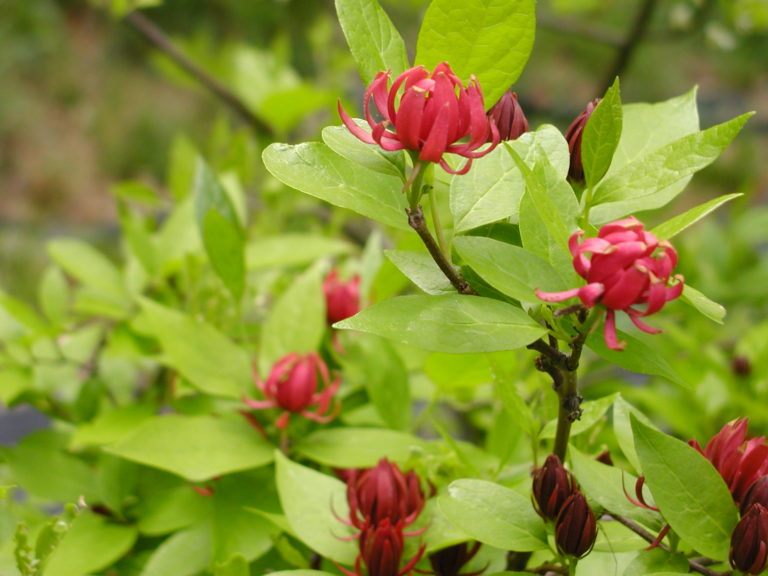Sweetshrub, or Carolina Allspice, is a deciduous woody shrub six to ten feet in height and equally wide famous for its heady aromas. In nature it is found on streamsides and in moist woodlands from Western NC into Tennessee and south into Alabama (Southern Appalachians and Piedmont), but being an old timey landscape plant, it is also found in many old Southern gardens and yards. Sweetshrub is densely branched, with opposite, leathery, leaves which are aromatic in their own right and turning golden in late autumn. But the plant also produces fragrant, upright, long-lasting burgundy-red flowers in early summer which develop into pendulous, wrinkly brown seed pods in fall. Though Sweetshrub thrives in partial shade, flowering and aroma are greatest when grown in full sun — but full sun also increases the suckering nature of this species. Siting the plant in partial to full shade will hold back its growth rate. Seedlings in nature vary greatly in the quality and strength of the fragrance.
NURSERY HOURS
Wednesday: 10-4 Thursday: 10-6 Friday-Saturday: 10-4 Sunday: 12-4
Calycanthus floridus

Key Info
Scientific Name: Calycanthus floridus L.
Common Names: Eastern Sweet Shrub, Carolina Allspice, Strawberry Shrub, Spicebush, Sweet Betsy, Sweet shrub, Sweet Bubby Bush
Family Names: Calycanthaceae (Calycanthus or Sweet Shrub Family)
Plant Type: Tree / Shrub
Leaf Retention: Deciduous
Flower Color: Burgundy red
Special Characteristics: Flowers fragrant, Leaves fragrant, Rhizomatous, Reported to be deer resistant., Tolerates drought
Additional Info
Habit: Upright shrub with multiple stems and rounded habit
Height: 6'-10'
Spread: 6'-12'
Soil Conditions: adaptable to acid, neutral and alkaline pH; prefers moist, deep loam
Leaves: Opposite, dark green oval-shaped leaves have a waxy/leathery texture; leaves turn yellow in the fall.
Flowers (or reproductive structures: 1-2 inch, dark red with undifferentiated petals and sepals (called tepals) producing no nectar.
Fruit: Brown seeds in a 3-inch, pendulous, dry, brown seed pod ripening in late fall (Oct./Nov.)
Natural Distribution: Open woods, wood edges, stream banks
USDA Hardiness Zone: 4 to 9
USDA Wetland Indicator Status in NC: FACU
Pollination: Mostly beetles, but also bees, butterflies, other insects
Wildlife Connections: Insects are attracted to the various fruity aromas of twigs, leaves and flowers, and birds follow the insects. Dense branching above furnishes nesting habitat, and low branches provide cover for ground birds and small mammals.
Propagation: Seeds; also hardwood root cuttings work somewhat.
